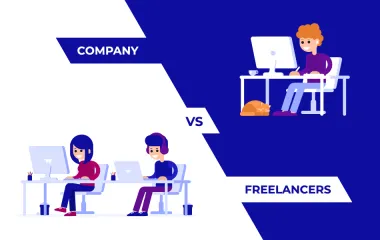Outsourcing Software Development: 10 Mistakes to Avoid

Software engineering projects require the use of complex development technologies. A developer might use AngularJS to build a highly interactive web app, Java for an Android app, or Swift for iPhone. For rapid prototyping that allows programmers to test and build apps in an efficient way, Ruby on Rails is a user-friendly application used by many of the big guys, including Twitter, Groupon, and Airbnb. Python is another favorite among software developers, largely because of its highly readable code. Unfortunately, even using state-of-the-art technologies doesn’t guarantee your project won’t fail. When this happens, the technology itself is rarely the cause of the breakdown. However, with the assistance of expert Python development services, you can significantly enhance the chances of your project’s success and ensure that your Python-based applications thrive.
Most problems that arise in software development are due to the “human factor.” This is especially true with outsourced software projects. At Waverley, we are keenly aware of this and it’s why we put so much attention on management and communication with our clients. Lack of commitment from either side, insufficient pre-planning, or inattention can derail even the best technology.
We know how to avoid these risks and common mistakes in software development outsourcing, which is why we have so many happy customers. Knowing where the pitfalls are, and knowing what to do to avoid them, will give you a leg up when you decide to outsource your software project. So, without further ado, here they are:
№1: Never Throw Your Project “Over the Wall” and Expect Good Results
Working with a software outsourcing company demands attention, organization, commitment, and skill. Of course, your company should be healthy internally when you go into the project. That way, when another company is added to the mix, you already know how to manage workflow, have defined areas of responsibility, and clear business strategy. No outside company can do this for you. If they promise that they will, my advice (based on +20 years experience) is that you take that promise as a yellow flag.
It’s surprising how often companies imagine that a software engineering project is just a matter of finding an outsourcing company to partner with, then fully entrusting that partner to fulfill on the project while they attend to other responsibilities. We call this throwing a project “over the wall.” It’s a useless strategy if what you want for your investment is a successful product.
Without clear goals, well-defined responsibilities, organized engineering process and time and commitment from both partners, you will achieve very little. You might even decide your brainchild or new innovation is nothing but trouble and give up the dream. However, when done well, partnering with a software outsourcing company gives you considerable benefits. These include:
- Shortening the time to market
- Reducing costs and improving productivity
- The ability to identify and cut bad ideas and work with good ones
- Improved internal processes for your company as a result of working closely with an outsourcing firm with domain experience.
№2: The Trust Factor

It goes without saying that lack of trust can kill any relationship. That’s why establishing trust with our clients is one of our top priorities at Waverley. We consider the trust factor a crucial element in our work with companies that come to us for help with software development. The development process itself requires a strong foundation that can only be laid down by humans who trust each other to invest themselves fully in the project’s success. Unfortunately, the trust factor is often underestimated. In practice, when two people begin working together, trust is assumed, but real trust needs to be built over time. We all know what it means to gain another’s trust. It comes down to the old adage: Actions speak louder than words. In the early stages it’s normal for team members from either organization to wonder:
- Are they capable of doing the job?
- How will this affect my career?
- Why do they ask so many questions?
- Do I have time to help them?
Every conversation, email, slack comment, and team call will either build trust, or undermine it. This is doubly true if, say, a milestone is not reached in the agreed-upon timeframe. A trustworthy partner will be honest and open; they will tell you the minute they realize they’re not on track with the milestone rather than wait until the end of a sprint or development cycle. In addition to getting in touch with an update as soon as possible, they will be clear about what they say or do. A commitment to the success of the project must be mutual because every engineering decision, conference call, and every line of code demands it.
№3: Be Honest
An important component of trust is full disclosure. There’s no reason to conceal bad news when both parties are committed to a project’s success. Outsourcing partners need clarity and honesty when it comes to all aspects of a project, such as:
- work schedule
- team priorities
- deliverables
- software quality
- documentation
- etc.
Most people can tell at once if the picture being presented is an accurate account of the project status, or if something is missing. So there’s every reason to be completely honest about all aspects of an outsourced project. Saying how it really is will help to correct small, niggling issues before they grow into large, vexing problems. All parties involved in a project need to be forthcoming with all information, good or not-so good, for the project to move toward completion as smoothly as possible.
№4: Commitment is Required From Senior Management on Both Sides
People in organizations take their guidance, both direct and indirect, from senior management. They’re unlikely to take major risks unless they are assured of support from above. Outsourcing a development project carries inherent risks so it’s vital that management from both companies are in full support of the endeavor whether a major change or minor improvement.
This begins by developing a shared vision of how the initiative will meet strategic objectives. Part of this shared vision is to state clearly how the two companies will contribute to their mutual success. Management can then develop and stand behind realistic requirements, success metrics, and clear communication methods to be used throughout the project.
№5: Knowledge Transfer is Critical

Any new software development outsourcing partnership needs to establish a procedure for knowledge transfer. The client and service provider must work together to define the product and the technical requirements of a new project. Incomplete knowledge transfer can cause major problems with outsourced products. A comprehensive knowledge base needs to be established early on, while team members are getting to know each other. In fact, this initial phase goes a long way to building the all-important foundation of trust. To facilitate this, make sure you do the following right from the start you:
- establish the project infrastructure
- analyze and mitigate risks together
- collect and disseminate both business and technical objectives
- prepare high-level estimates and project plans
- examine milestones and contingencies
- choose a software development life cycle (SDLC)
- debate management procedures and discuss them with a team
- learn each other’s goals and expectations
- create a detailed project plan and technology stack for the service or product to be delivered
The knowledge transfer phase of a new software development outsourcing partnership does not need to be long or cumbersome, but it’s critical. In addition, keep in mind: you don’t just share the information once and tick it off your to-do list. It doesn’t work like that. You need to come back again and again, sharing new knowledge and information as it emerges so that both sides are constantly in the loop.
№6: Outsourcing is All About Collaboration
Collaborative partnership in the software outsourcing model is the process of bringing different teams with different skills together to maximize results. At Waverley, we believe that great partnerships are synonymous with success. And partnership (as both a requirement and a benefit) is a two-way street.
When each partner brings their talent and energy to the table, they create synergy. That synergy results in a product or service that is beyond what the client could have produced running solely on its own steam. We encourage our clients to think like partners, and we bring in our top talent to help them reach success.
№7: Transparency is Good, Micromanagement is Not
At Waverley, we believe in software outsourcing transparency. By transparency, we mean that all team members are available to the client. Nothing is concealed and everything is discussed in detail upfront. However, roles and management are crucial. On larger projects, it makes sense to have a Team Lead, a Client Manager, UI designers, and a team responsible for documentation.
To that end, we leverage our considerable skill in engineering project management. It’s easy to fall into the trap of trying to manage each engineer remotely across time zones. This style of engagement devolves into cumbersome micromanagement. What’s more, it is not scalable and tends to cause frustration, which hamstrings productivity and slows the project down.
№8: Be Prepared to Solve Issues
Working together on any creative or technical effort that is complex by nature is guaranteed to hit snags and stir controversy. Accept that this will happen, encourage tough questions, clarify your concerns, get the answers you need, and be willing to work together to address issues as they arise. Working this way builds both trust and confidence. And, as a bonus, when difficult issues get resolved by team effort, everybody gets energized.
№9: Understand Your Goals Up Front

Clear goals drive your overall work on a project toward a vision that has been stated up front. While goals such as “high quality,” “fast time” or “low cost” are obviously important, it’s even more important to parse them out and clarify smaller, more specific goals.
For example, let’s say the project is to deliver a backup solution. A more specific goal would be to have backups restart in the event of a power or network failure. Another essential would be for the data to be restored perfectly. Or for the restore to happen automatically without needing a human to initiate it. When management states clear, specific goals, the empower the team to make the project successful.
№10: Build Momentum Slowly
One way to establish a new outsourcing software development relationship is to start with a small project. This allows both parties to find out how members of their respective teams fit together before moving to larger, more impactful projects. We call this “crawl, walk, run.” Like trust, momentum can’t be rushed.
The time investment will pay off in future more substantial efforts if the partners are already in the active phase of a relationship. You know this is happening when you find yourselves reading each other’s minds, finishing each other’s sentences, telling jokes on team calls, and creating amazing high-quality products on time and on budget.
Bottom line: It is crucial to embrace the fact that outsourcing is based on people. Outsourcing is not so much a process or a method, as it is a relationship. We hope you will find our experience useful and outsourcing your software engineering projects will be a positive experience for you.



